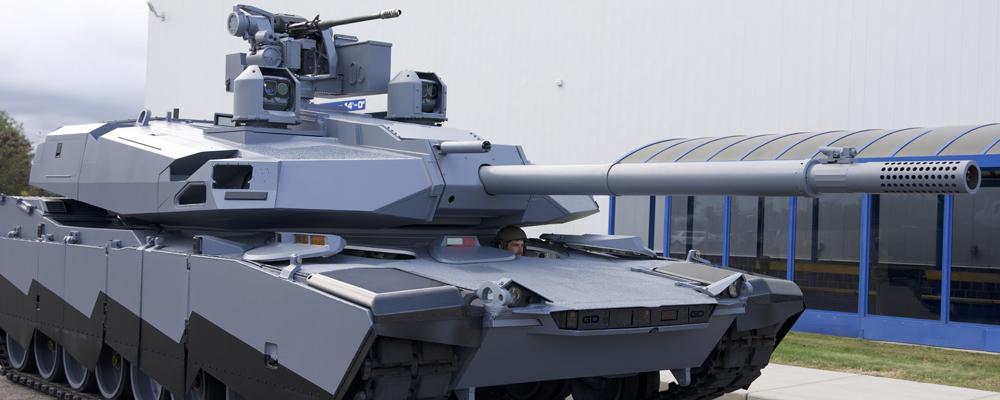
New Charge
After generations of service around the globe in a vast array of models, gas-powered vehicles are on the way out of the U.S. military.
The move is part of a Defense Department plan to field fully electrical fleets of non-tactical vehicles by 2035 and tactical vehicles by 2050. It follows White House climate and energy orders aimed at reducing the burning of the fossil fuels that generate greenhouse gas emissions.
Congress made the 2035 deadline law in the fiscal 2023 National Defense Authorization Act.
Officials believe the greater frequency of severe weather events is attributable to rising greenhouse gases, which have increased the urgency to transition to clean-energy alternatives. And the U.S. military is the world’s largest-known institutional user of petroleum products, accounting for half of the federal government’s carbon footprint.
Recent severe weather has left its mark on DoD facilities. Hurricane Michael in 2018 destroyed half the buildings at Tyndall Air Force Base, Florida. A year later, the Missouri River flooded, swallowing up a third of the Offutt Air Force Base, Nebraska, and causing more than $500 million in damage.
Defense leaders also cite the melting polar ice caps and the wildfires in the western U.S. that now draw hundreds, sometimes thousands, of Guardsmen almost every summer. They have since elevated climate to a national security issue in the National Defense Strategy.
But going electric will be no easy task. In the Army National Guard alone, it involves the conversion of 13,000 non-tactical vehicles — sedans, vans, pickup trucks and commercial buses — and 86,000 tactical vehicles.
Step one, according to the Army’s climate strategy implementation plan, is shifting light-duty non-tactical vehicles to hybrid or electric vehicles in the next four years.
Hybrids can operate on fossil fuels or electricity. They come in two basic types: hybrid electric vehicles, or HEVs whose batteries are charged from the gas engine, and plugin hybrid electric vehicles, or PHEVs, which are charged from external sources.
Service goals include a 50% reduction of net greenhouse gas pollution by 2030 compared to 2005 levels, and attaining net-zero greenhouse gas emissions by 2050.
“It is important to be a part of the solution and not be a part of the problem,” says Col. Timothy Wood, the National Guard Bureau’s logistics officer. “So, we move forward, not just because it’s just an executive order, but because it’s the right thing to do and fall in line with our future.”
A test by the Colorado Army Guard provided some proof of concept. From 2019 to 2020, it replaced five non-tactical vehicles with electric vehicles and one plugin hybrid, reducing gas and maintenance costs by $2,000 per vehicle.
Fewer moving parts in EVs reduce maintenance and related costs. They also don’t require regular oil changes.
But to go fully electric, the Army Guard faces some added challenges as a community-based force. Unlike the active-component Army, whose infrastructure is largely self-contained on large installations, Guard units are in smaller facilities scattered across states, which creates logistical obstacles in providing charging stations.
The solution: Rely on hybrid vehicles while converting the non-tactical fleet, Wood says.
“As we convert, going to a hybrid version first allows us some time and flexibility to meet climate strategy goals, but at the same time continue with our mission,” he explains.
Wood says the Army Guard is also considering electric microgrids at armories. This would mean linking several buildings with underground connections to provide more charging stations. Besides supporting climate-change initiatives, existing diesel-fuel power could be connected to electric charging options.
Things figure to be a little simpler in the Air Guard, which will follow the Air Force climate strategy. The Guard’s flying service has far fewer vehicles, and most of the force operates on 180 installations in 159 communities nationwide.
Hybrids will also be the bridge to move tactical vehicles to electricity, largely because all the required technology to go fully electric does not currently exist, said Paul Farman, the Army’s principal deputy assistant secretary for installations, energy and environment, last year.
Among the issues is charging combat vehicles on the battlefield, Farman said. “The honest answer is, I don’t know,” he explained. “And that’s why the goal is up to 2050. Because we don’t know how we’re going to get there yet.”
Maj. Gen. John M. Epperly, the deputy commanding general, Army National Guard at Army Futures Command put the situation another way: “The idea that we’re going to divorce the Army from fossil fuels in the near future is probably fantastical at best.”
The defense industry is already developing some hybrid combat vehicles. BAE has delivered two HEV Bradley fighting vehicles to the Army for testing. And HEV versions of the Joint Light Tactical Vehicle and the Humvee are expected to arrive from Oshkosh Defense and AM General, respectively, this year.
Meanwhile, General Dynamics Land Systems exhibited HEV AbramsX and StrykerX technology demonstrators at last year’s AUSA Exposition. The company says the AbramsX delivers the same tactical range as the M1A2 Abrams with 50% less fuel consumption.
And Pentagon planners are considering the addition of anti-idling technology to some vehicles. The technology, which turns the engine off when the vehicle is sitting still, would cut fuel consumption by as much 20% overall, according to some estimates.
It is important to be a part of the solution and not be a part of the problem.
—Col. Timothy Wood, the National Guard Bureau's logistics officer
EVS LOOK AND OPERATE similarly to their internal combustion engine counterparts. The main difference is under the hood. While an ICE burns fuel to create heat, which creates the force to propel a vehicle forward, an electric motor turns electrical energy into mechanical energy.
Not only are there no tailpipe emissions with EVs, the propulsion is quieter and produces a much lower heat signature, both of which are significant operational advantages on the battlefield, says Jim Miller, BAE’s senior director of business development for combat mission systems.
EVs get their power from charged lithium-ion batteries. Mobile phones operate with a single Li-ion battery. Vehicles require a pack of thousands of individual Li-ion cells working together. This is also where EVs can be controversial.
The minerals in these batteries are mined mostly overseas in nations with few environmental controls. Many can also be hostile to the U.S. More ominously, China accounts for roughly 60% of the world’s lithium chemical supply, according to the International Energy Agency, and dominates the world EV battery market.
Additionally, batteries capable of providing enough electricity to power bigger vehicles are currently large and heavy.
There are other downsides. EVs are currently more expensive than comparable gas-powered models. They require readily available charging stations and take much longer to recharge than ICE vehicles take to refill using petroleum products. Additionally, prices for electricity are rising and figure to continue in that direction with increased demand.
EV sedans currently get from 200 to 400 miles on full charge, but much less in cold weather, which slows the chemical and physical reactions that make batteries work. Multiple reports indicate EVs lose up to 35% of their range in the cold.
This will create issues for the Guard in northern states that have isolated units and long frigid winters, Col. Anthony Hammett, the Army Guard’s chief of installations, environment, and energy.
Further development of EV battery technology could solve some of the charging and power degradation problems.
But other challenges could emerge. One is continued funding from Congress. Some influential lawmakers are skeptical of climate change. Others believe the military should focus less on climate change and more on readiness and lethality, especially in the current security environment.
“What confounds me — I don’t get this at all — is all of this push behind electric vehicles, not drilling, not refining here in the United States, which means that we’re relying on China,” Sen. Joni Ernst, R-Iowa, a member of the Senate Armed Services Committee, told Defense News in December.
Ernst, a retired Iowa Army Guard lieutenant colonel, was instrumental in pushing the deadline for non-tactical vehicles to go fully electric from 2030 in the original legislation to 2035 in the fiscal 2023 NDAA.
The move to EVs also represents a big change to vehicle maintainers who’ve spent careers dealing with petroleum, oil and lubricants.
“It’s going to drive a huge training requirement,” says Senior Master Sgt. Tom Parrish, the vehicle management superintendent at the Wisconsin Air Guard’s Volk Field Combat Readiness Training Center.
Parrish adds that the sooner the charger infrastructure is built, the sooner that training can begin.
The idea that we're going to divorce the Army from fossil fuels in the near future is probably fantastical at best.
—Maj. Gen. John M. Epperly, the deputy commanding general, Army National Guard at Army Futures Command
THE U.S. MILITARY is not out front in the EV world. It also doesn’t want to fall far behind the latest advances in technology.
“We should be fast followers,” said Timothy Goddette, the deputy assistant Army secretary for sustainment, at the National Defense Industrial Association’s Tactical Wheeled Vehicles Conference in Columbus, Ohio, in February.
“We should be looking at the technologies and looking at the opportunity where we can bring it in — not just because the technology is ready — but because it’s affordable, because it’s reliable and because we’re taking advantage of the great industrial base that we have,” Goddette said.
Industry has been working on alternatives to gas-powered for decades. But the effort didn’t get real traction in the marketplace until Toyota released the Prius HEV in the U.S. in 2000.
Today, nearly every car-maker offers a range of hybrids and EVs, from sedans to sports utility vehicles to pickups. And sales are beginning to boom.
Approximately 12% of all cars sold in the U.S. in January and February were plug-ins (EVs or PHEVs) according to the Argonne National Laboratory, a Department of Energy research center. But that all-time high amount is only slightly more than half the 2022 figure in Europe. The market is also growing in Japan.
Manufacturers see a trend and are leaning into it.
General Motors, and its new defense subsidiary, GM Defense, is investing $35 billion in electric vehicles and self-driving technology through 2025. Volkswagen has committed to making electric cars account for 40% of its sales by the end of the decade. And Ford announced that in 2023 it will spend more on EVs than on ICE vehicles.
Some of the investment is to prepare for looming government action. President Joe Biden wants half of all new cars sold in the U.S. by 2030 to be EVs. California, which has long had the most stringent environmental laws, will ban the sale of new gas-powered cars by 2035. Several other states are looking to follow suit. The European Union is looking to do the same.
Nonmilitary federal government fleets are also going electric under the White House order. The U.S. Postal Service recently announced that it expects to acquire at least 66,000 electric delivery vehicles as part of its 106,000 vehicle acquisition between now and 2028. USPS has a delivery fleet of more than 220,000 vehicles.
Corporate fleets are also converting. Amazon has placed an order for 100,000 electric delivery vans and has promised to reach net-zero carbon emissions by 2040. FedEx has committed to the same deadline with plans to completely electrify its pickup and delivery fleet by then.
Even Domino’s is buying specially branded EVs to use for pizza deliveries. Judging by its television ad campaign, the company believes it is great PR and a good marketing tool.
Going electric also comes with obstacles for the private sector, but none bigger than what the military faces in figuring out how to recharge electric combat vehicles on the battlefield.
Mark Hensch and John Goheen can be reached via magazine@ngaus.org. Sgt. 1st Class Whitney Hughes contributed reporting to this story.



